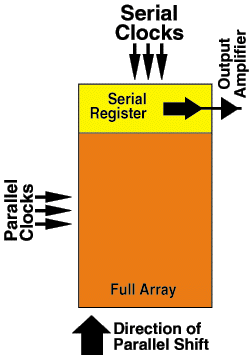Full-Frame CCDs
Among charge-coupled devices, full-frame CCDs have the simplest architecture. The classical full-frame CCD design employs a single parallel register for photon exposure, charge integration, and charge transport. In order to control the exposure and block light from striking the CCD during the read process (which would otherwise result in charge smearing) a mechanical shutter is used.
In a full-frame format, the total area of the CCD is available for sensing incoming photons during the exposure period. The format boasts 100% fill factor, which means that 100% of each pixel is being utilized to detect photons during the exposure. The pixels are typically square so there is no image distortion inherent to the detector.
Full-frame CCDs are designed for either frontside illumination or backside illumination. Back-illuminated devices provide better quantum efficiency (QE) since light does not need to traverse the gate structures overlaying the photosensitive region of the detector. Newer technologies help raise the QE of front-illuminated CCDs by making the gates more transparent to light.

